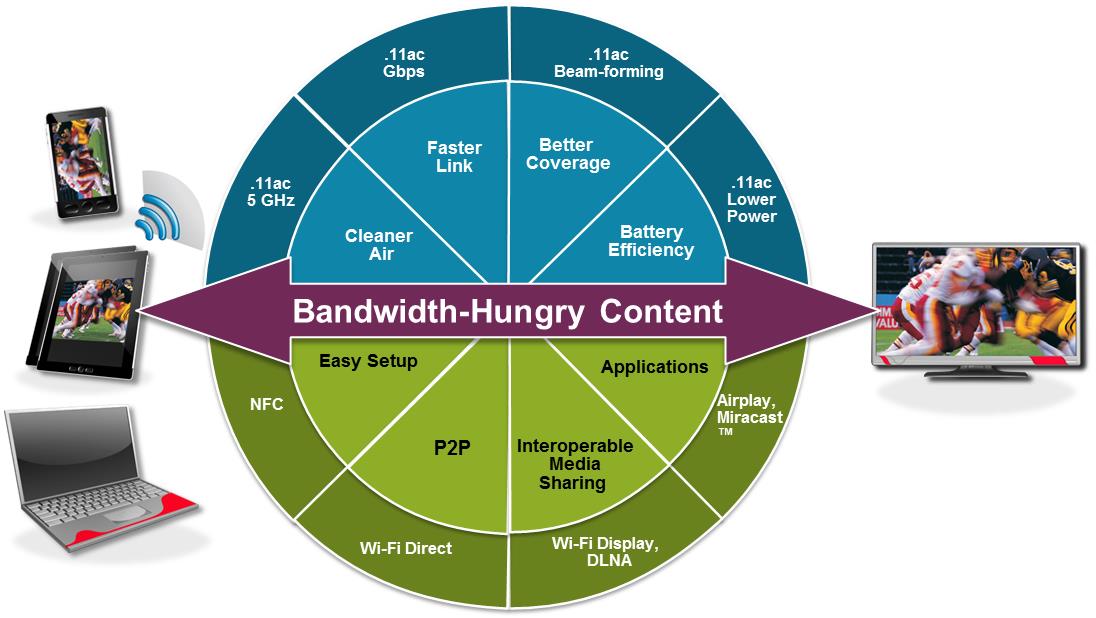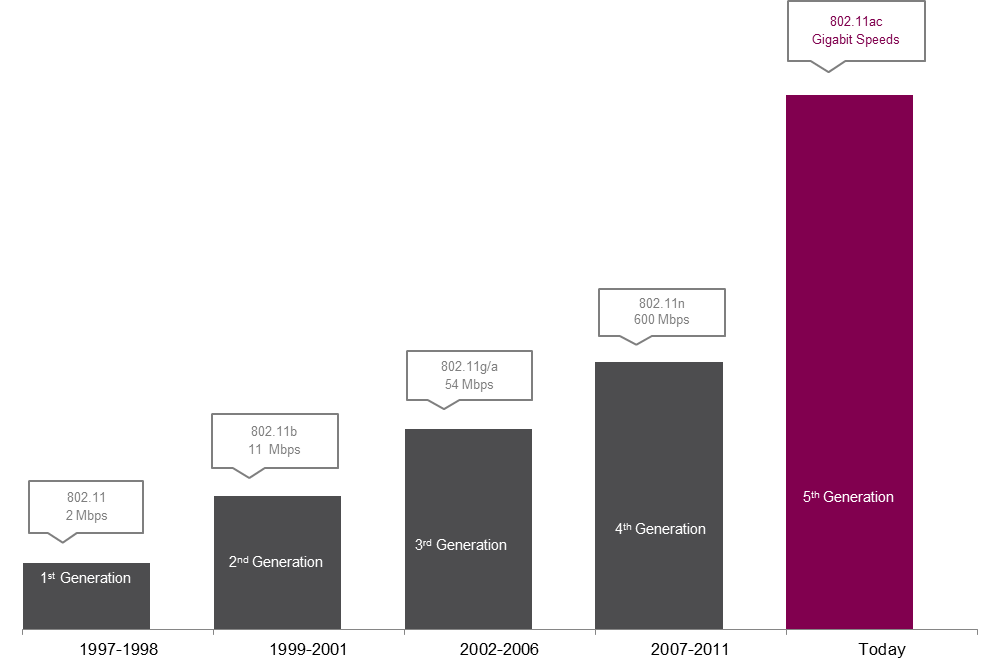In 2007, Apple’s first iPhone hit the shelf. That same year, the fourth generation of Wi-Fi® technology—802.11n—was introduced as a wireless technology to meet the demand for medium-resolution video such as those found on the then two-year old startup YouTube.
Fast forward to 2012 when the number of smartphone users worldwide broke the one billion mark, tablet sales grew greater than 78% in a single year and video traffic accounted for more than half of all Internet traffic. Certainly, the architects of 802.11n could not have anticipated this explosion of mobile data traffic in such a short amount of time.
By eliminating the physical constraints of wired electronic devices, Wi-Fi has spawned a generation of savvy users who now consume digital content at an ever increasing rate. That’s where IEEE 802.11ac comes in, promising to deliver extraordinary improvements in speed, reliability and range necessary to meet the demands of more users, more devices and more data (Figure 1).
Figure 1. 802.11ac delivers the bandwidth required for streaming high-quality media such as live television broadcasts and streaming HD video.
The 802.11ac protocol, referred to by Broadcom as the fifth-generation of Wi-Fi or 5G WiFi, is essentially the next step in the evolution of Wi-Fi from 802.11n (Figure 2). 802.11ac represents a dramatic leap forward — up to three times faster and up to six times more power efficient than equivalent 802.11n.
Figure 2. Wi-Fi has evolved through the years to accommodate demands for faster data rates and greater bandwidth to support more feature-rich content and applications.
In addition to its speed, 802.11ac increases reliability, and can achieve up to 4x the bandwidth increase over its predecessor using 160 MHz channels; a critical factor in enabling bandwidth-intensive mobile video and voice applications. In addition, it uses a higher modulation scheme—256 QAM as compared to 802.11n’s 64 QAM—which provides more efficient data transfer and in turn, increased battery life. 802.11ac is also powerful enough to cover a broader range and robust enough to handle more devices transmitting data-heavy content, including high definition video and an array of other new use cases for today’s video-obsessed consumers. And that’s just the beginning.
The protocol operates in the 5 GHz band where it enjoys up to 8x more capacity, faster data rates and broader coverage with fewer dead spots. The band is divided into 24 non-overlapping channels with each having the potential to be used in a single wireless system. By comparison, 802.11n primarily operates in the congested 2.4 GHz band with its 14 channels, only three of which are used in North America due to interference issues.
Because it operates in the 5 GHz band, 802.11ac more efficiently uses the air space shared by all wireless technologies. Essentially, it transmits data through the air at a higher rate, enabling devices to get off the channel faster and leaving air for other devices to transmit and receive. As a result, 802.11ac realizes a dramatic reduction in Wi-Fi network congestion.
As an added benefit, 802.11ac is backward compatible. This is especially important given the huge number of Wi-Fi devices already in use. Having the backward compatibility ensures 802.11ac devices will be able to connect to existing 802.11 protocol networks operating in the same 5 GHz band, albeit at slower speeds.
The performance improvements and functionality possible with 802.11ac translate into a host of benefits for consumers, the enterprise, and service providers alike. For consumers, it means increased bandwidth and battery life to enjoy a much more content-rich multimedia experience, faster throughput that will allow content to be streamed in less time, and the capacity for multiple devices to be simultaneously connected to the network.
In the enterprise, as the number of mobile devices and the deployment of cloud-based enterprise networks continues to scale at a dramatic rate, IT managers must reconsider how they provision, secure and control enterprise computing resources and information access. 802.11ac provides the bandwidth and range required for applications such as video conferencing and customer relationship management (CRM) applications, delivering speeds that rival Gigabit Ethernet and offer compatibility with centralized wired networks. 802.11ac also supports a higher number of users with fewer dead spots.
Service providers, reeling from the network overload caused by increasingly data-hungry devices, will also benefit from 802.11ac. The protocol’s greater capacity for offloading data traffic will enable many more simultaneous connections, offering users a better experience. Moreover, service providers won’t need to deploy the same density of access points to get the same coverage.
Just this year, ABI Research reported that worldwide shipments of consumer Wi-Fi customer premises equipment topped 43.3 million. 802.11n devices constitute the majority of that total; however, 802.11ac access point adoption is gaining traction. Strategy Analytics expects sales of consumer devices with 802.11ac to surpass one billion by 2015. While some may dispute how long it will take for the protocol to become dominant, one thing is certain: more devices, more apps and more multimedia are coming down the pipeline. 802.11ac is well positioned to deliver the performance required to address this impending media explosion head on.
The statements and opinions by each Wi-Fi Alliance member and those providing comments are theirs alone, and do not reflect the opinions or views of Wi-Fi Alliance or any other member. Wi-Fi Alliance is not responsible for the accuracy of any of the information provided by any member in posting to or commenting on this blog. Concerns should be directed to info@wi-fi.org.





Wi-Fi Next Generation of Wireless
Wi-Fi Next Generation of Wireless
Adding this feature to my
Misleading
This information explained
I have a question about 5 Ghz wireless HDMI transmitter
Thank you for your comment
The same 5 GHZ but different protocols have different products
Add new comment